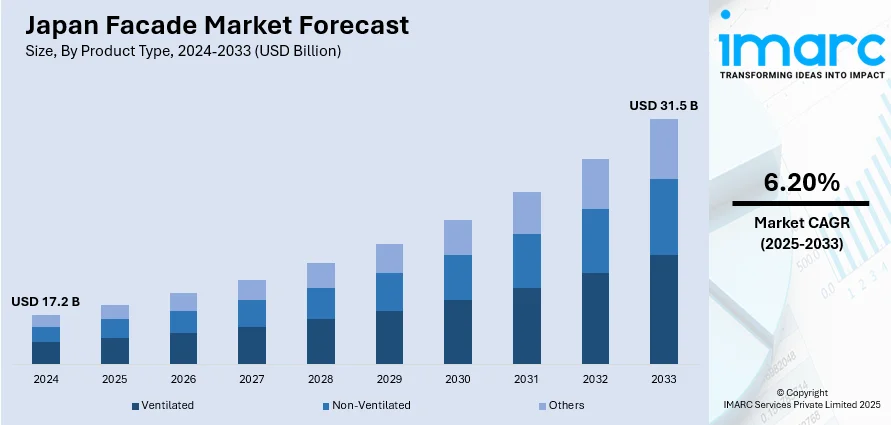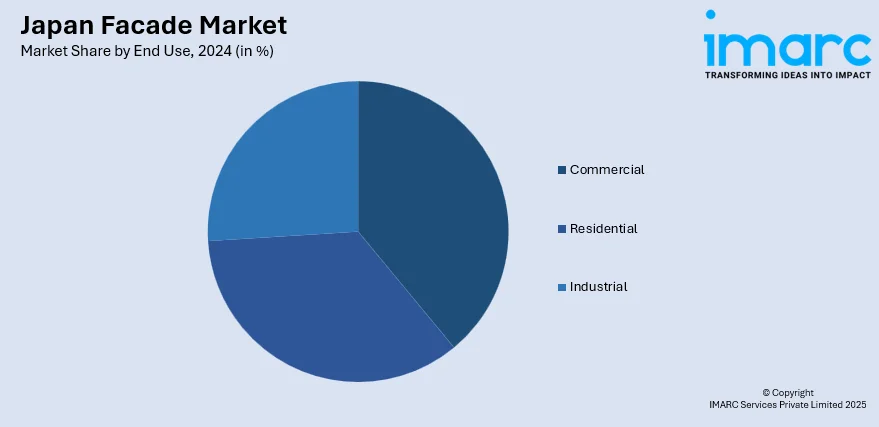
Japan Facade Market Size, Share, Trends and Forecast by Product Type, Material, End Use, and Region, 2025-2033
Japan Facade Market Overview:
The Japan facade market size reached USD 17.2 Billion in 2024. Looking forward, IMARC Group expects the market to reach USD 31.5 Billion by 2033, exhibiting a growth rate (CAGR) of 6.20% during 2025-2033. Rising demand for energy-efficient buildings, strict environmental regulations, urban redevelopment projects, technological advancements in materials, aesthetic preferences, and increased high-rise construction are some of the factors propelling the growth of the market. Government incentives and a focus on sustainable infrastructure further support market growth across commercial and residential sectors.
|
Report Attribute
|
Key Statistics
|
|---|---|
|
Base Year
|
2024 |
|
Forecast Years
|
2025-2033
|
|
Historical Years
|
2019-2024
|
| Market Size in 2024 | USD 17.2 Billion |
| Market Forecast in 2033 | USD 31.5 Billion |
| Market Growth Rate 2025-2033 | 6.20% |
Japan Facade Market Trends:
Growing Focus on Architectural Exteriors
Japan is witnessing increased momentum in the facade segment, supported by rising international capital inflows into the construction sector. Large-scale development projects are driving demand for exterior solutions that combine functionality with modern design. This shift is fostering interest in high-performance materials, improved building envelopes, and energy-efficient systems. The growing emphasis on structural quality and visual appeal is prompting the adoption of advanced cladding, curtain walls, and other exterior elements in both new and retrofit construction. With ongoing investments in infrastructure and urban development, exterior applications are gaining broader importance across commercial, residential, and public spaces. The market is gradually aligning with global preferences for sustainable, durable, and visually striking building exteriors in a fast-evolving architectural environment. For example, in December 2024, JETRO published the Invest Japan Report 2024, revealing that inward foreign direct investment stock in Japan exceeded 50 trillion yen. This surge is attributed to large-scale projects, including those in the construction and facade industries, indicating a robust growth in these sectors.

International Partnerships Reshaping Exterior Design Space
Collaborations between domestic and international firms are becoming more prominent in Japan’s facade sector. Over the past decade, there has been a steady rise in joint ventures and technical partnerships, particularly in construction and architectural applications. These alliances are facilitating the exchange of design expertise, innovative materials, and modern engineering practices. As global players engage more actively with local counterparts, the facade market is seeing broader access to advanced technologies and specialized solutions. This growing cooperation is influencing both the aesthetics and performance standards of exterior structures. The integration of global insights with local building needs is helping redefine approaches to urban design, sustainability, and construction efficiency in Japan’s evolving built environment. For instance, in April 2024, the Ministry of Economy, Trade and Industry (METI) compiled case studies on collaborations and joint ventures between Japanese and foreign companies. The report highlights a significant increase in such partnerships over the past decade, showcasing the growing international cooperation in Japan's construction and facade sectors.
Japan Facade Market Segmentation:
IMARC Group provides an analysis of the key trends in each segment of the market, along with forecasts at the region/country level for 2025-2033. Our report has categorized the market based on product type, material, and end use.
Product Type Insights:
- Ventilated
- Non-Ventilated
- Others
The report has provided a detailed breakup and analysis of the market based on the product type. This includes ventilated, non-ventilated, and others.
Material Insights:
- Glass
- Metal
- Plastic and Fiber
- Stones
- Others
A detailed breakup and analysis of the market based on the material have also been provided in the report. This includes glass, metal, plastic and fiber, stones, and others.
End Use Insights:

- Commercial
- Residential
- Industrial
The report has provided a detailed breakup and analysis of the market based on the end use. This includes commercial, residential, and industrial.
Regional Insights:
- Kanto Region
- Kansai/Kinki Region
- Central/Chubu Region
- Kyushu-Okinawa Region
- Tohoku Region
- Chugoku Region
- Hokkaido Region
- Shikoku Region
The report has also provided a comprehensive analysis of all the major regional markets, which include Kanto region, Kansai/Kinki region, Central/Chubu region, Kyushu-Okinawa region, Tohoku region, Chugoku region, Hokkaido region, and Shikoku region.
Competitive Landscape:
The market research report has also provided a comprehensive analysis of the competitive landscape. Competitive analysis such as market structure, key player positioning, top winning strategies, competitive dashboard, and company evaluation quadrant has been covered in the report. Also, detailed profiles of all major companies have been provided.
Japan Facade Market News:
- In January 2025, Sumitomo Group unveiled the completed façade of the Sumitomo Pavilion for Expo 2025 Osaka, Kansai, Japan. The design emphasizes sustainability, utilizing approximately 1,000 trees from Sumitomo-owned forests, reflecting the group's commitment to environmental responsibility.
Japan Facade Market Report Coverage:
| Report Features | Details |
|---|---|
| Base Year of the Analysis | 2024 |
| Historical Period | 2019-2024 |
| Forecast Period | 2025-2033 |
| Units | Billion USD |
| Scope of the Report |
Exploration of Historical Trends and Market Outlook, Industry Catalysts and Challenges, Segment-Wise Historical and Future Market Assessment:
|
| Product Types Covered | Ventilated, Non-Ventilated, Others |
| Materials Covered | Glass, Metal, Plastic and Fiber, Stones, Others |
| End Uses Covered | Commercial, Residential, Industrial |
| Regions Covered | Kanto Region, Kansai/Kinki Region, Central/Chubu Region, Kyushu-Okinawa Region, Tohoku Region, Chugoku Region, Hokkaido Region, Shikoku Region |
| Customization Scope | 10% Free Customization |
| Post-Sale Analyst Support | 10-12 Weeks |
| Delivery Format | PDF and Excel through Email (We can also provide the editable version of the report in PPT/Word format on special request) |
Key Questions Answered in This Report:
- How has the Japan facade market performed so far and how will it perform in the coming years?
- What is the breakup of the Japan facade market on the basis of product type?
- What is the breakup of the Japan facade market on the basis of material?
- What is the breakup of the Japan facade market on the basis of end use?
- What are the various stages in the value chain of the Japan facade market?
- What are the key driving factors and challenges in the Japan facade market?
- What is the structure of the Japan facade market and who are the key players?
- What is the degree of competition in the Japan facade market?
Key Benefits for Stakeholders:
- IMARC’s industry report offers a comprehensive quantitative analysis of various market segments, historical and current market trends, market forecasts, and dynamics of the Japan facade market from 2019-2033.
- The research report provides the latest information on the market drivers, challenges, and opportunities in the Japan facade market.
- Porter's five forces analysis assist stakeholders in assessing the impact of new entrants, competitive rivalry, supplier power, buyer power, and the threat of substitution. It helps stakeholders to analyze the level of competition within the Japan facade industry and its attractiveness.
- Competitive landscape allows stakeholders to understand their competitive environment and provides an insight into the current positions of key players in the market.
Need more help?
- Speak to our experienced analysts for insights on the current market scenarios.
- Include additional segments and countries to customize the report as per your requirement.
- Gain an unparalleled competitive advantage in your domain by understanding how to utilize the report and positively impacting your operations and revenue.
- For further assistance, please connect with our analysts.
 Request Customization
Request Customization
 Speak to an Analyst
Speak to an Analyst
 Request Brochure
Request Brochure
 Inquire Before Buying
Inquire Before Buying




.webp)




.webp)












